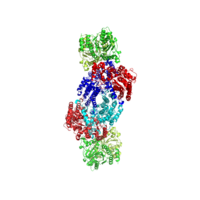
Photo from wikipedia
Mo-nitrogenase catalyzes the challenging N2-to-NH3 reduction. This complex reaction proceeds through a series of intermediate states (En) of its active site FeMo-cofactor. An understanding of the kinetics of the conversion… Click to show full abstract
Mo-nitrogenase catalyzes the challenging N2-to-NH3 reduction. This complex reaction proceeds through a series of intermediate states (En) of its active site FeMo-cofactor. An understanding of the kinetics of the conversion between En states is central to defining the mechanism of nitrogenase. Here, rate constants of key steps have been determined through a steady-state kinetic model with fits to experimental data. The model reveals that the rate for H2 formation from the early electron populated state E2(2H) is much slower than that from the more reduced E4(4H) state. Further, it is found that the competing reactions of H2 formation and N2 binding at the E4(4H) state occur with equal rate constants. The H2-dependent reverse reaction of the N2 binding step is found to have a rate constant of 5.5 ± 0.2 (atm H2)-1 s-1 (7.2 ± 0.3 (mM H2)-1 s-1). Importantly, the reduction of N2 bound to FeMo-cofactor proceeds with a rate constant of 1 ± 0.1 s-1, revealing a previously unrecognized slow step in the Mo-nitrogenase catalytic cycle associated with the chemical transformation of N2 to 2 NH3. Finally, the populations of En states under different reaction conditions are predicted, providing a powerful tool to guide the spectroscopic and mechanistic studies of Mo-nitrogenase.
Journal Title: Biochemistry
Year Published: 2022
Link to full text (if available)
Share on Social Media: Sign Up to like & get
recommendations!